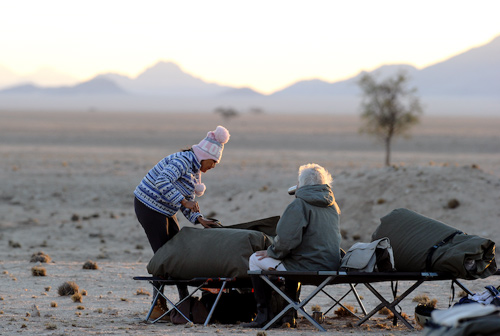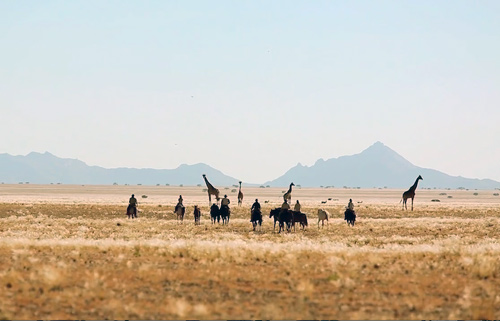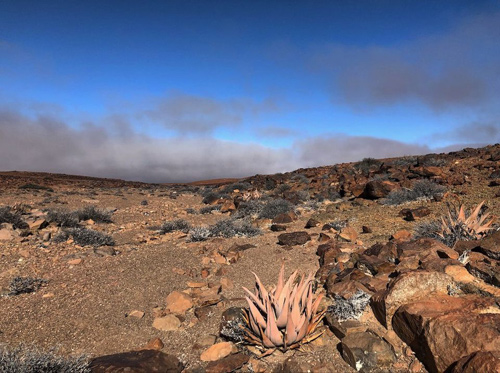Great Namibian Desert Trail
Namibia Namibia: (PG-NANW)
URL: https://www.hiddentrails.com/tour/namibia_desert_crossing_riding_tour.aspx
Introduction
Namibia
Namibia
Central Namibia offers spectacular and fascinating contrasts; from Khomas Highland mountains and escarpment to the Kuiseb Canyon; the Tinkas, Tumas and Welwitschia plains, Moon Valley, the seasonal Swakop River and the coastal dunes of the Atlantic Ocean. Crossing the oldest desert in the world on horseback is an experience of a lifetime! Arguably one of the most scenic deserts on the planet, the Namib, with its iconic ocher dunes and vast grassy plains, is a sensual delight. With a surprisingly varied wildlife for this seemingly inhospitable ‘wasteland’, it holds wonderful surprises for those who have the eyes to see.
Explore unique and spectacular desert landscapes on super fit and responsive horses.
You will ride fast for long stretches and yet, with some preparation, it is within the capabilities of most seasoned riders. Throughout the rides you are accompanied by an excellent horse people and adventurer whose riding and organizational skills will continually impress you. The horses are strong and fit as they live on the rough terrain in the bush.
This horse riding safari from near Sossusvlei to Swakopmund on the Atlantic Coast this is our most challenging ride and not for the faint-hearted but is, undeniably, the ride of a lifetime!
Accomodation
Accommodations
This is a wilderness ride, so you will be staying in a mixture of lodges and camping.
Description
You will be staying in a lodge for 2 nights and camp for 8 nights. Consider yourself ‘unplugged’ while on safari – cell-phone reception is minimal at best and internet not at all except in cities and larger towns. Water is a very precious commodity in a desert, so while it is possible to rinse a few smalls things on safari, only lodges and hotels have laundry service.
Accommodation Itinerary - subject to changes based on availability
Night 1 & 2: Lodge in Windhoek
Night 3 & 4: Camping in Naukluft
Night 5 & 6: Camping in Gaub/Kuiseb canyons
Night 7 - 9: Camping in the Namib Plains by Swakop River
Night 10: Camping in Swakopmund

Lodge in Windhoek
The main lodge building comprises a dining room, a centrally situated bar, a lounge with fireplace, a conference room and a boardroom. Nestled outside, between the lounge and dining area, is the pool (great for swimming lengths – it really is quite long!) The elevated wooden deck offers a fairytale view of Windhoek. The Lodge and the rooms have been designed to emulate old German farm houses – think ‘stoep’ with ‘afdakkie’ and pots of geraniums. The 20 guest chalets consist of 14 twin chalets and 6 double chalets (all chalets have ensuite bathrooms with showers, toilets, and basins). Two of the chalets have been designed with honeymooners in mind and have baths instead of showers. All rooms have feather duvets wrapped in 100% cotton, environmentally friendly guest amenities, and unparalleled service and hospitality. 6 chalets offer views of Windhoek and 14 face east offering superb sunrise views of the Moltkeblick Mountain. You'll also have WIFI available.

Camping
While we do provide tents if needed, generally guests sleep out under the stars on cozy cots with bedding. The cots have bedrolls consisting of an insulating mattress, duck-down double duvet, and pillow - can zip up and has a waterproof cover. Hot bucket showers and chemical loos travel along with us - we endeavor to provide a shower every night but if water is scarce, one night might be shower-less.
Room Occupancy
Single supplement is waived if you are willing to share.

Meals
All meals are included from dinner on Day 1 to breakfast on the last day.
Breakfast is typically porridge or cereal, coffee or tea and a hot dish.
On days we are able to meet up with the supply trucks a light lunch is served, where this is not possible, sandwiches are enjoyed under a shady tree.
Dinner is a delight of typically Namibian fare; wild Game, free-range beef or Karoo mutton served as braai (grilled over an open fire) or potjie (pot casserole) with vegetables and a surprise dessert also made on the open fire.
Tea, coffee, and juice are always available in camp with chilled drinks, beer, wine, etc. available in the evenings. All drinks are included in the cost whilst on the ride. Only drinks at the first night lodges, guest farms, restaurants, and petrol stations while en-route are not included in the package rate.
Dietary Restrictions
We can easily cater to vegetarians. We cannot fully cater to vegans, so please supply your own snacks.
This trip includes
some wine with dinner
and can accommodate special dietary requests.
Riding

Riding Level
Do not underestimate the physical toll living outside take on you- come very fit! You need to be balanced in the saddle and stay off your horse's back without having to hang onto their mouth at all paces. You need to be able to post trot. This is one of our most challenging ride, requiring a technical scramble into and out of the Kuiseb Canyon.
If you do not ride regularly (2 - 3 times a week), we strongly recommend that you get into practice before joining one of our challenging safaris. This is a challenging ride suitable for confident intermediate riders. Please not, we reserve the right to prevent anyone from riding if we feel they do not fulfill the minimum competence level as indicated or if weight and fitness level do not fall within that recommended for these challenging safaris.
Pace
You will ride in the morning for 4-5 hours, have a lunch break for 1-2 hours, and then continue riding for another 2-3 hours, totaling around 6-8 hours per day in the saddle for 7 days. You will cover 20-60km per day at all paces and over rough terrain. Other days may be less. This is one of our longest ride with a total of 300 km covered!
Pace depends on the terrain and temperatures as well as on fitness and weight of riders with walk, trot, canter and gallop.
Because Namibia has such wide-open spaces, it is possible to accommodate up to 15 riders on most trails plus 2 - 3 riding guides.
Horses
Your horse will be chosen from a mixed herd of many breeds i.e. Arab, Haflinger, Trakehner, ranch horses, they are small to medium-sized (14.3 to almost 16 hands) sure-footed horses raised on rough terrain, some of them with experience in endurance riding, and every one of them a kind, reliable companion that deserves the very best treatment and care.
Each rider is responsible for grooming, regularly checking over, and tacking up their own horse (assistance is given when required). It is this experience that cements the bond between you and the horse you must rely on to carry you across the desert.
Tack
We use skirted endurance type saddles with heavy padding for the comfort of horse and rider. Each saddle is fitted with two specially made water bottle holders (water bottles supplied). If you normally ride with a sheepskin bumnah you may bring your own (western shaped). We use a simple snaffle bridle over the halter
Weight Limit
We have a strict weight limit of 85 kg dressed in your riding gear – fit riders heavier than this will need to hire a 2nd horse. Our absolute maximum weight limit is 93 kg.
Hard Hats
Hard hats are obligatory, unless medical insurers acknowledge that you will still be insured, should you choose not to wear a hard hat.
Safety
Your safety and enjoyment are of paramount importance to us while you are our guest. Please alert us to any personal medical condition, allergies included and ensure you have all essential personal medication before arriving in Windhoek.
Children & Non-Riders
Experienced children riders who are accompanied by their parents are welcome – but please remember that these rides can be quite strenuous – so parents must use their judgment as to whether their children are suitable. Anyone unable to keep up with the group may have to travel in the support vehicle at some times. Non-riding companions are also welcome to join the trip and travel with the trucks.
Insurance
Comprehensive medical insurance is required to ride with us. Ensure repatriation is included in your policy. Travel insurance is recommended.
Itinerary

Sample Itinerary - subject to changes
Days begin at sunrise with the smell of freshly brewed coffee wafting through camp, followed by breakfast; departure is generally by 8am with 4 – 5 hours riding before lunch. Lunch breaks are an hour to 2 hours followed by another 2 – 3 hours riding in the afternoon.
Day 1: Arrival
Arrive Windhoek’s Hosea Kutako Airport –airport transfer to overnight lodge where you will meet the other riders and guide for dinner and a briefing.
Day 2: To the Namib!
Transfer to desert (about a 5-hour drive), through some spectacular Namib landscapes including a dramatic drop off the escarpment with an arresting view of the desert below. After lunch we depart for a visit to the dunes at Sossusvlei, returning to camp by sunset.
Days 3 and 4: First Ride
Our first ride begins amid the encircling Naukluft (German for ‘narrow gorge’) – a short ride before lunch allows you to get more acquainted with your horse before we ride into the undulations and isolated hills which are a feature of this area.
Days 5 and 6: The Canyons
While Namibia’s westward-flowing rivers rarely flow, they all run through deep valleys etched at a time when Namibia was wetter and sea levels were lower. We cross two river canyons on our way to the Namib plains; the Gaub and the much larger Kuiseb which forms a dramatic end to the 400 km long Namib Sand Sea. Following the tracks of Mountain Zebra which crisscross the steep sides of the canyon, a technical descent requires some walking/scrambling into and out of the Canyon. The high, narrow walls of the canyon preserve an almost year-round supply of precious water for the
game in this area.
Days 7 to 10: Namib Plains to the Swakop River
Good going affords some fast-paced riding on the wide grassy plains on the Namib. Dry watercourses, distinguishable by the long lines of acacia trees marking their courses, are much favored resting place of Giraffe, Springbok and Oryx. As the plains become more arid strange shapes form and disappear in mirages and dinosaur-like plants, the gnarled Welwitschia Mirabilis, tell of a land of great antiquity and also of tremendous solitude. The Swakop river basin has eroded a truly ancient geology (600 million years old) exposing a bizarre moon like landscape. Curious black ridges of dolerite intrusions form whalebacks on the hills surrounding the river basin. And finally to the sea with the last canter along the beach - the end of a truly epic adventure.
Day 11: Departure for Windhoek Airport
Early breakfast and transfer to Windhoek (just over 4-hour commute) arriving in time for departure flights from Windhoek International Airport after 3 pm.

Rates and Dates for Great Namibian Desert Trail
Rates include:
All accommodations - 8 nights camping, 2 nights lodge -- and meals, drinks in camp, 7.5 riding days, transfers, sightseeing to the World Heritage site of the Namib Sand Sea at Sossusvlei
Minimum Deposit: ~$50.00 per person
* prices are per person based on double/twin occupancy
Transfer and Other Charges:
|
2019
|
Transfer from/to Windhoek Airport included
|
£
0
|
$0
|
|
2019
|
Over 85 kg (extra horse charge)
|
£
935
|
$1,255
|
|
2019
|
Single supplement
|
£
225
|
$305
|
Dates Note:
Rates do not include:
Souvenirs; tips for local guides and crew; extra horse (if over 85kg), drinks at lodges/ hotels
Other Info
Meeting: Windhoek
Airport: Windhoek
Transfer: Windhoek aiport
Climate:
Swakopmund area
|
Month
|
Jan
|
Feb
|
Mar
|
Apr
|
May
|
Jun
|
Jul
|
Aug
|
Sep
|
Oct
|
Nov
|
Dec
|
|
Average High Temperature (°F)
|
71
|
71
|
71
|
71
|
70
|
70
|
68
|
65
|
64
|
65
|
67
|
69
|
|
Average Low Temperature (°F)
|
59
|
60
|
58
|
56
|
53
|
52
|
50
|
49
|
50
|
52
|
54
|
57
|
|
Average High Temperature (°C)
|
22
|
22
|
22
|
22
|
21
|
21
|
20
|
18
|
18
|
18
|
19
|
20
|
|
Average Low Temperature (°C)
|
15
|
15
|
15
|
13
|
12
|
11
|
10
|
9
|
10
|
11
|
12
|
14
|
|
Average Precipitation (days of rain)
|
0
|
0
|
0
|
0
|
0
|
0
|
0
|
0
|
0
|
0
|
0
|
0
|
Source: NOAA
Seasons
This is Africa and the climate reflects it. But just as Namibia is filled with contrasting geography, equivalent climactic differences do apply depending on your location.
Partially covered by the Namib, one of the world's driest deserts, Namibia's climate is generally very dry and pleasant. The cold Benguella current keeps the coast cool, damp and free of rain for most of the year (when it does rain it is between October and April). Inland, all the rain falls in summer (November to April). January and February are hot, but nights are usually cool. Winter nights can be fairly cold, but days are generally warm and quite nice.
Keep in mind that temperatures vary hugely seasonally and geographically – coastal areas much cooler than inland, often subject to fog (10 – 20 degrees Celsius). Day and night temperatures, particularly in winter, vary dramatically (below zero to 30’s). Weather in desert is always highly variable and unpredictable – come prepared to all weather – layering is key to living in a desert.
The bottom line: Namibia is a year-round destination. Just pack accordingly.
An excellent weather report reference can be found on:
www.yr.no/place/Namibia
What To Bring:
What to Bring
Place all items in soft luggage, well labeled, and split into 2 bags if over 15kg- lots of pockets help with organizing.
Essential Items
Headlamp
Beanie / Woollen hat
Hat / Baseball
cap
Fleece jacket
Buff / Bandana
Clothing
Long sleeved
cotton shirts for riding x 4 (preferably in subtle colours)
Riding
trousers/jods x 3
Casual trousers x 2 (for travelling and excursion
days)
Shorts x 1 (in summer for around camp)
T-shirt x 2
Long sleeved
shirts for the evenings x 2 (also for lodge nights)
Pullover x 2
Warm
‘Pyjamas’ x 1
Lightweight waterproof jacket (for foggy
mornings)
Lightweight down jacket / vest
Underwear, Socks
Flip
Flops
Comfortable walking shoes / trainers (for around camp, travel
etc.)
Riding Gear
Helmet (recommended not compulsory, but might
be a condition from your insurance – please check!) Sun visor to fit around
helmet or Wide brimmed Hat (with a string)Boots / Chaps - full or
half
Gloves
Seat saver (if
needed)
Accessories
Sunglasses
Sunblock SPF 50 & Lip
balm (with SPF!)
Toiletries (Shampoo, Toothbrush and -paste, wet wipes,
moisturiser)
Personal medication / Pain killers (for sore
muscles)
Camera
Power bank / extra batteries/ spare memory card
|
|